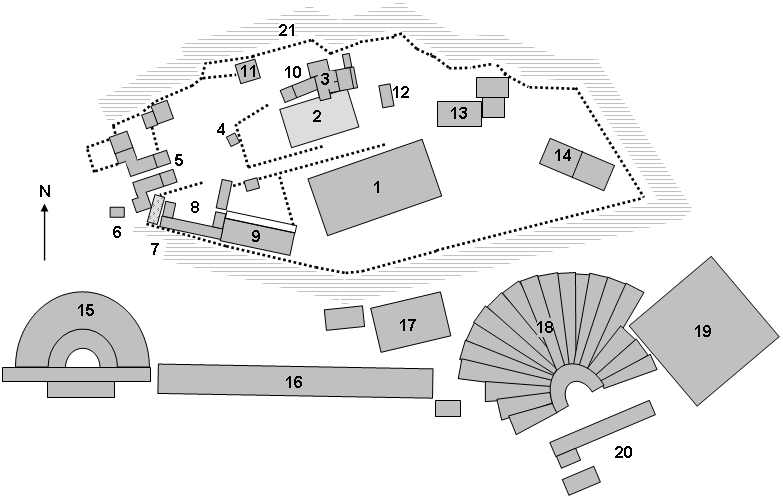Pandion's sanctuary on:
[Wikipedia]
[Google]
[Amazon]
 The Sanctuary of Pandion is the name sometimes given to the remains of a building located in the south-east corner of the
The Sanctuary of Pandion is the name sometimes given to the remains of a building located in the south-east corner of the
pp. 157–158
Robertson
pp. 40–41
1.5.4
Online version at the Perseus Digital Library
* Robertson, Noel (1996), "Athena's Shrines and Festivals" in ''Worshipping Athena: Panathenaia and Parthenon'', The University of Wisconsin Press.
Sanctuary of Pandion
Acropolis of Athens Ancient Greek buildings and structures in Athens Ancient Greek sanctuaries in Greece 5th-century BC religious buildings and structures {{AncientGreece-stub
 The Sanctuary of Pandion is the name sometimes given to the remains of a building located in the south-east corner of the
The Sanctuary of Pandion is the name sometimes given to the remains of a building located in the south-east corner of the Acropolis of Athens
The Acropolis of Athens is an ancient citadel located on a rocky outcrop above the city of Athens and contains the remains of several ancient buildings of great architectural and historical significance, the most famous being the Parthenon. Th ...
. Its foundations were found during the excavations for the construction of the Old Acropolis Museum
The Old Acropolis Museum ( el, (Παλαιό) Μουσείο Ακρόπολης ''(Palaio) Mouseio Akropolis'') was an archaeological museum located in Athens, Greece on the archeological site of Acropolis. It is built in a niche at the eastern e ...
(1865–1874).
The 40m by 17m rectangular open-air building, dating to the later 5th century, was divided into two nearly equal parts by a wall. It faced west-northwest and was entered through a projecting portico
A portico is a porch leading to the entrance of a building, or extended as a colonnade, with a roof structure over a walkway, supported by columns or enclosed by walls. This idea was widely used in ancient Greece and has influenced many cult ...
on the western side.
The name stems from the presumption that this was the location of the heroon (hero shrine) of Pandion, the eponymous hero of the Attic tribe Pandionis (usually assumed to be one of the two legendary kings of Athens
Before the Athenian democracy, the tyrants, and the Archons, the city-state of Athens was ruled by kings. Most of these are probably mythical or only semi-historical. The following lists contain the chronological order of the title King of Athens ...
, Pandion I
In Greek mythology, Pandion I (; Ancient Greek: Πανδίων) was a legendary King of Athens, the son and heir to Erichthonius of Athens and his wife, the naiad Praxithea. Through his father, he was the grandson of the god Hephaestus.
Family
...
or Pandion II In Greek mythology, Pandion II ( or ; Ancient Greek: Πανδίων) was a legendary King of Athens, the son and heir of King Cecrops II and his wife Metiadusa, daughter of Eupalamus.
Family
Pandion was the father of Aegeus, Pallas, Nisos, Lycu ...
), which was known to be located somewhere on the Acropolis.Jonespp. 157–158
Robertson
pp. 40–41
Pausanias Pausanias ( el, Παυσανίας) may refer to:
*Pausanias of Athens, lover of the poet Agathon and a character in Plato's ''Symposium''
*Pausanias the Regent, Spartan general and regent of the 5th century BC
* Pausanias of Sicily, physician of t ...
1.5.4
Notes
References
* Jones, Nicholas F., ''The Associations of Classical Athens : The Response to Democracy: The Response to Democracy'', Oxford University Press, 1999. . *Pausanias Pausanias ( el, Παυσανίας) may refer to:
*Pausanias of Athens, lover of the poet Agathon and a character in Plato's ''Symposium''
*Pausanias the Regent, Spartan general and regent of the 5th century BC
* Pausanias of Sicily, physician of t ...
, ''Pausanias Description of Greece with an English Translation by W.H.S. Jones, Litt.D., and H.A. Ormerod, M.A., in 4 Volumes.'' Cambridge, Massachusetts, Harvard University Press; London, William Heinemann Ltd. 1918Online version at the Perseus Digital Library
* Robertson, Noel (1996), "Athena's Shrines and Festivals" in ''Worshipping Athena: Panathenaia and Parthenon'', The University of Wisconsin Press.
External links
Acropolis of Athens Ancient Greek buildings and structures in Athens Ancient Greek sanctuaries in Greece 5th-century BC religious buildings and structures {{AncientGreece-stub